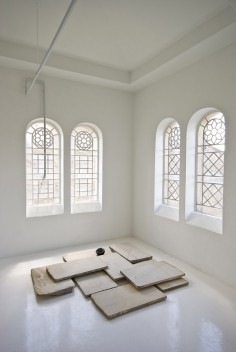Katinka Bock

source: henryartorg
Katinka Bock est une artiste qui, sans aucun doute, renvoie au temps présent les questionnements qu’il lui impose. Mais elle a surtout développé avec une assurance et une justesse admirable un travail unique, qui prolonge, d’un côté, les possibilités d’expansion de la sculpture par la sculpture; de l’autre, elle l’ouvre à la forme presque désincarnée, processuelle et protocolaire sans pour autant la disséminer. «Die Zierkel» (2009), exprime cette porosité de l’œuvre dans le contexte: un crayon accroché à l’extrémité inférieure d’une porte trace son mouvement sur le sol comme s’il lui arrachait une essence, somme toute aussi banale qu’extraordinaire une fois révélée comme un dessin/dessein potentiel. Elle a déjà choisi d’immobiliser ce geste, mais il peut tout aussi bien être perpétué par l’acheteur de la pièce: c’est alors que ce processus si profond de comprendre l’immensité spatio-temporelle prend toute son ampleur. Au lieu de nous mettre face à l’évidence d’une immensité passée, Bock nous tourne vers le futur. Le potentiel acquéreur de cette pièce, pour autant qu’il l’installe et la pratique, est mis devant le potentiel à venir de la vie matérielle. Telle est la force de Katinka Bock.
.
.
.
.
.
.
.
source: vleeshalnl
Katinka Bock reconceptualizes the environment of De Vleeshal through installation works and sculptures that create a relationship between the space’s interior and exterior landscapes. As so often in her work, this joining of inside and outside explicitly includes the weather. Rain, wind and sun are allowed a direct influence on De Vleeshal’s interior. Consequently, the art works exhibited here will be shaped by time, changing over the duration of the exhibition.
Space and landscape are recurring features in Katinka Bock’s work. In De Vleeshal, this fascination with environments is related to the longstanding Dutch tradition of landscape painting. Using simple, natural materials – employed in such a way that their fragile, precarious changeability is revealed – Bock creates physical, historical and social interconnections between elements of De Vleeshals’s environment. Die Diagonal (2009), for example, explores the space of the hall through measurement of its components. April Table (2009) reflects the passage of time. A final example is the ceramic installation The Ground of the Sea (2009), which analyses how elements of a space may display the traces of time.
On the occasion of the opening of The Sound of Distance, on 10 April 2009, the band Infinite Mind will give a live performance of their project Studio Visit (concept: Katinka Bock, text: Thomas Boutoux, music: Infinte Mind) in the basement of De Vleeshal.
.
.
.
.
.
.
.
.
source: moussemagazineit
Katinka Bock was born in Frankfurt am Main in 1976. She studied in Berlin, Dresden, Paris, and then at the École Nationale des Beaux-Arts in Lyon, before coming to Paris in 2007 for a residency lasting several months at the Cité des Arts. Although she was based in Berlin, circumstances have led her to stay on in the French capital. Sculpture has always been at the heart of her studies and interests, though she has also experimented extensively with video, performance art and projects for public spaces. Since coming to Paris, she has ceased to work on collaborative projects, and she finds that the most fertile place for her is not her studio or house, but her mind itself. At Kunsthochschule Berlin Weißensee (KHB) in Berlin, where she began her artistic training, the working conditions – from a technical, practical, and logistical standpoint – were anything but ideal, yet Katinka says that these very shortcomings became a crucial factor: a contingent state that proved to be fundamental for understanding how ideas often germinate when there is a dearth of materials. And, I would add, this proved decisive in shaping an aesthetic, an exploration of form and a choice of materials that make Katinka Bock’s work some of the most unusual on the contemporary scene.
This German artist’s pieces are utterly devoid of any opulence or redundancy, and in their rigorous poverty and radical austerity, they resonate energy and tension. Cement, terra-cotta, stone, metal, wood: commonplace materials, chosen not for their natural appearance, but due to their primary aspect, their intrinsic qualities, their vitality. Chosen, or rather, found. The way that one may find “a pebble by a river, sand on the beach, water in a fountain, a flagstone on the street, a newspaper on the sofa or on the subway”.

